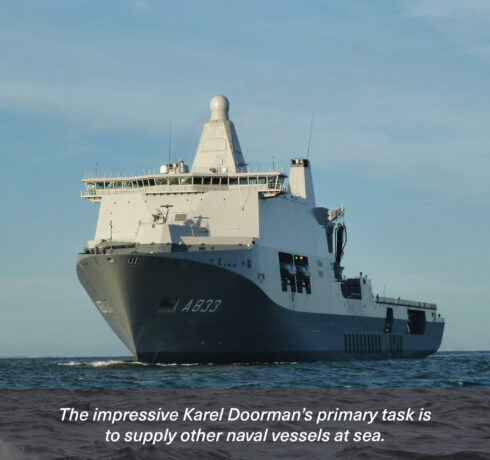Damen Naval has had the pleasure of delivering many unique ships in recent years. HNLMS Johan de Witt, HNLMS Karel Doorman and the ARSV Nuyina are just three of them, but what they have in common is that Joop Noordijk was the Project Director for all three. Here he talks about the largest ship of the Royal Netherlands Navy and the largest ship ever built by Damen Naval: the impressive Joint Logistic Support Ship (JSS) Karel Doorman.
HNLMS Karel Doorman is a welcome guest at international naval exercises. Most recently, for instance, the ship took part in the Joint Viking exercise in Norway in March 2023, in which more than 20,000 soldiers, 50 aircraft and 40 ships from nine countries took part. Last year, the JSS was the flagship of Standing NATO Maritime Group 1 (SNMG1) for three months (an alternating task currently performed by HNLMS Tromp). All in all, the eight-year-old ship’s impressive track record doesn’t really surprise Joop.
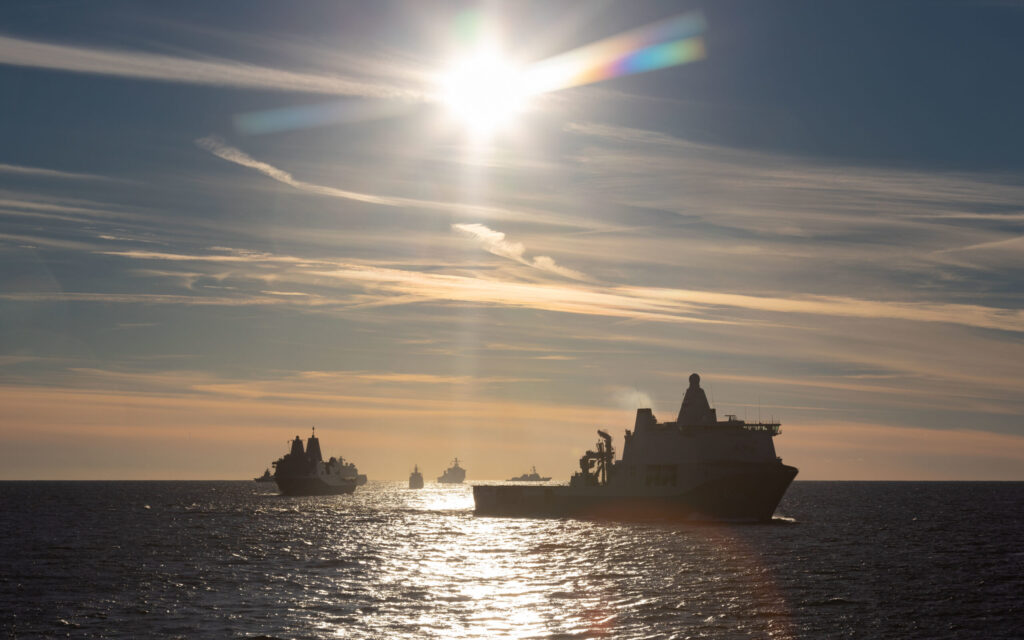 HNLMS Karel Doorman sails across the Baltic Sea during her stint as the flagship of Standing NATO Maritime Group 1.
HNLMS Karel Doorman sails across the Baltic Sea during her stint as the flagship of Standing NATO Maritime Group 1.
“HNLMS Karel Doorman is a special ship, and it was a special project to lead. It was a project that certainly had its challenges, especially because it was such a big ship and therefore a big project,” Joop says. “At the peak of engineering, as many as 150 people were working on the project. And at the height of construction, it was between 700 and 800. But all that hard work produced a beautiful ship.”
The Karel Doorman’s primary task is to supply other naval vessels at sea. For this, the ship is equipped with two masts that can transfer liquids such as fuel and drinking water to the receiving ship. In addition, pallets of food or ammunition can be exchanged between the ships via a cable, or the goods can be transferred by a helicopter.
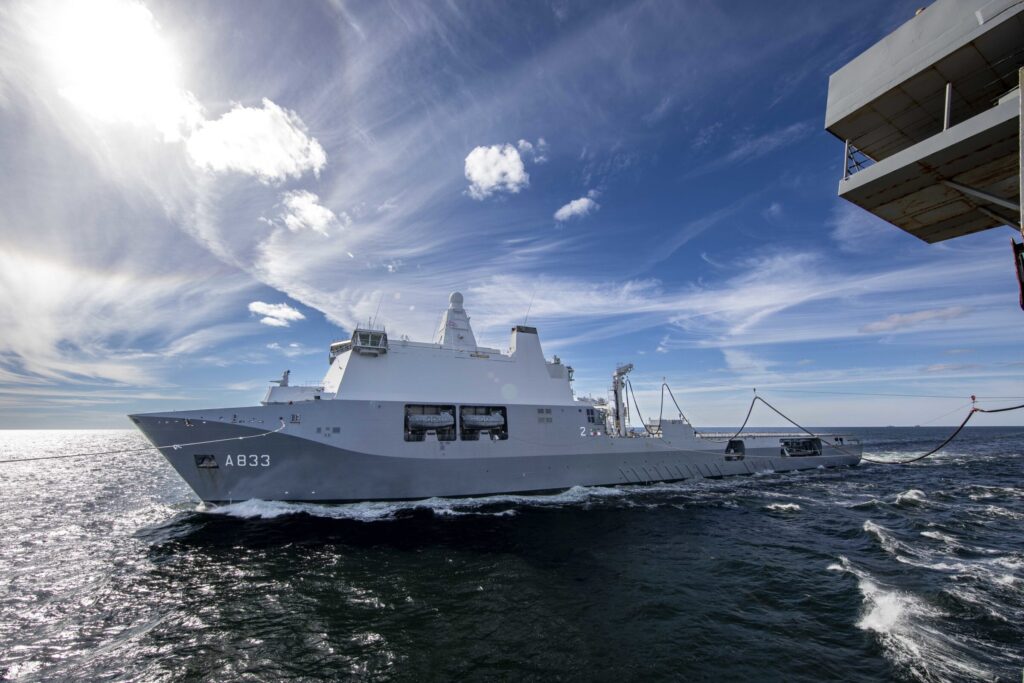 To supply other naval vessels at sea, the Karel Doorman is equipped with two masts capable of transferring liquids such as fuel and drinking water.
To supply other naval vessels at sea, the Karel Doorman is equipped with two masts capable of transferring liquids such as fuel and drinking water.
Inside the ship is a hangar with space for two Chinook helicopters with extended rotors or six NH90 helicopters with folded rotor blades. Below the flight deck is the vehicle deck that allows the ship to transport vehicles and materials. There is also a roll-on-roll-off hatch for quick loading and unloading of vehicles. At the rear of the ship is a so-called ‘Landing beach’, a kind of loading ramp to supply Landing Craft Units. Furthermore, there is room for 300 people on board, including the ship’s own crew of about 150.
“What is nice about this kind of project is that the ships operate for at least 30 years and sooner or later you are confronted with them again.” Joop Noordijk
A notable detail is that the ship has the same mast as the four Offshore Patrol Vessels (OPVs) built by Damen Naval during the same period. The mast of the JSS was actually initially intended for one of the OPVs. “The delivery of the mast for the Karel Doorman was delayed, so the mast might not have been installed in time for delivery to the COMMIT,” Joop recalls. “It was therefore decided to adapt an OPV mast to the specifications of the Karel Doorman.”
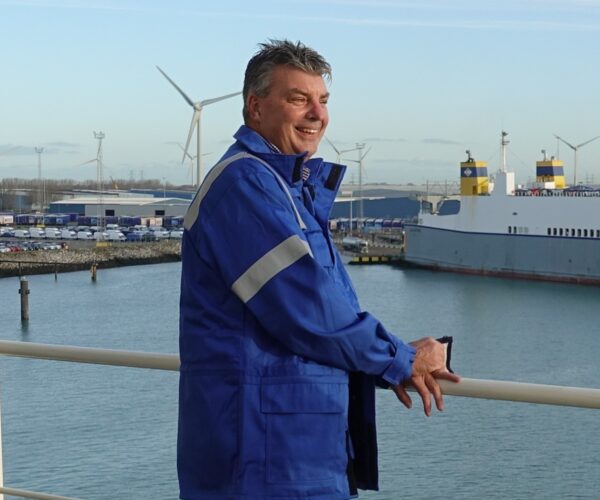 Project Director Joop Noordijk.
Project Director Joop Noordijk.
Joop had been involved in the negotiation phase from 2008, but it took until 8 December 2009 when the contract was signed. The engineering phase started immediately afterwards, and construction began at Damen Shipyards Galati (DSGa), Romania in early 2011. Construction of the 204.7-metre vessel was not without its challenges. The dock was not exactly designed to accommodate a ship the size of the Karel Doorman, which meant that only some of the work on the hull could be carried out in the dock. “The dock has draft restrictions, so the ship could not become too heavy, otherwise we wouldn’t have been able to float it,” Joop recalls. “We could build up to a certain level in the dock. As a result, the ship came out of the dock and alongside the quay at a fairly early stage, where we could continue with the rest of the construction.”
On 22 July 2013, the ship left for Vlissingen for further construction. The JSS could not yet sail under its own power and was towed by the large tug Eide Wrestler. In order to manoeuvre across the Danube, help was sought from a second and very special tug. Joop: “Multraship from Terneuzen had had two new tugs built by Damen in Galați; they were delivered in the same period. I contacted director Leendert Muller and asked if one of the two tugs could stay in Galați a little longer to help us with the Karel Doorman. So a Zeeland-based tug built by Damen helped us get down the river.”
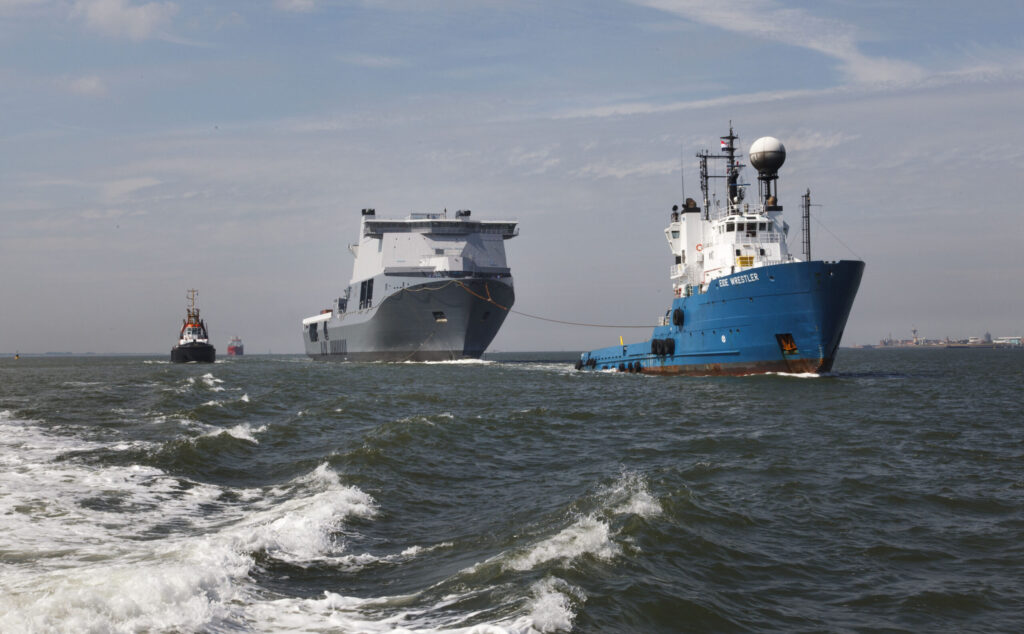 The Karel Doorman, still without her distinctive mast, arrives in Vlissingen for further construction.
The Karel Doorman, still without her distinctive mast, arrives in Vlissingen for further construction.
As the Karel Doorman sailed down the Danube, a small crew was on board to make sure everything went smoothly. Joop himself followed by car. “I drove behind the ship with Aurelian Nistor from DSGa to guide the ship to the end of the Danube. The ship is so big that we kept seeing it sticking out above the treetops. There is quite a sharp bend in the river near Tulcea, and as the Karel Doorman was a long tow, it was quite a challenge. But it all went well.” Fortunately, the towing operation went without a hitch and the ship arrived in Vlissingen on 16 August 2013 for final outfitting and the official christening.
The logistics support ship is the fourth Netherlands Royal Navy ship to be named after Rear Admiral Karel Doorman, who was killed during the Battle of the Java Sea in 1942. A hint about the vessel’s future name was given during the keel-laying on 7 June 2011, when a golden ten guilder coin from 1889 – the birth year of the naval hero – was welded to the keel. On 27 February 2012, the name of the new ship was officially confirmed by Commander of the Royal Netherlands Navy Vice Admiral Matthieu Borsboom at the 70th anniversary commemoration of the Battle of the Java Sea.
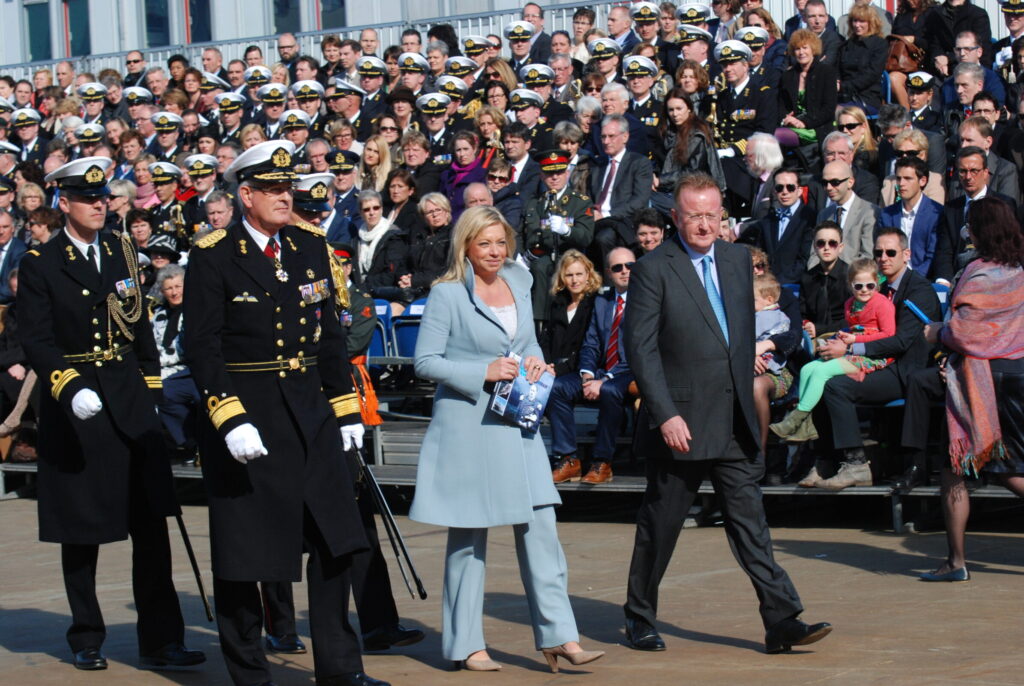 On 8 March 2014, the official christening took place, carried out by the then Dutch Defence Minister Jeanine Hennis-Plasschaert.
On 8 March 2014, the official christening took place, carried out by the then Dutch Defence Minister Jeanine Hennis-Plasschaert.
A little more than two years later, on 8 March 2014, the official christening took place, carried out by the then Dutch Defence Minister Jeanine Hennis-Plasschaert. It was the biggest christening ever organised by Damen Naval. On a surprisingly sunny and warm day, some 1,300 guests gathered at Vlissingen-Oost. “There were large stands on Quay E and we were really lucky with the weather. It was a spectacular event with marines abseiling from the ship and from a crane. Afterwards, there was a party on board,” says Joop.
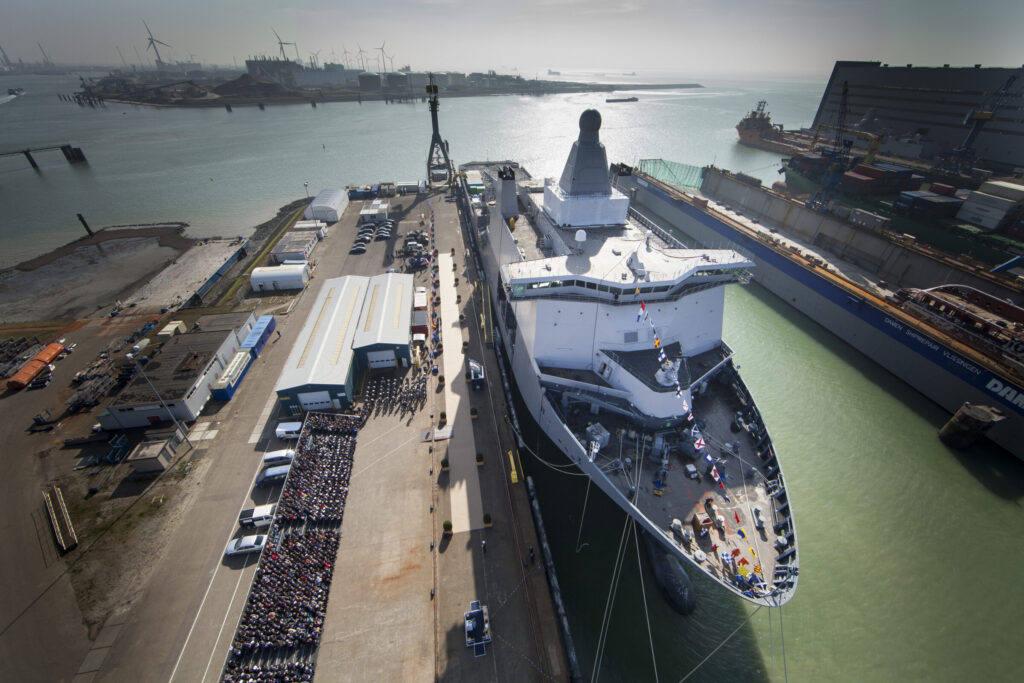 With over 1,300 guests, the christening of HNLMS Karel Doorman was the largest ever organised by Damen Naval.
With over 1,300 guests, the christening of HNLMS Karel Doorman was the largest ever organised by Damen Naval.
The next milestone on the schedule was the sea trials. “It is always exciting when the ship leaves the quayside for the first time,” says Joop. “Getting to that point is special, it doesn’t happen automatically, so the fact that you manage to do so is very special. We stayed on the Westerschelde for the first day, because you still want to make sure everything works. Then we sailed to the deeper waters off the south coast of England.”
The ship was officially handed over to the Dutch Ministry of Defence during the World Port Days in Rotterdam on 4 September 2014, and almost immediately afterwards Joop was already busy working on his next project: the design and construction of the icebreaker and research vessel Nuyina for Australia. “What is nice about this kind of project is that the ships operate for at least 30 years and sooner or later you are confronted with them again,” Joop concludes. “As soon as I hear Johan de Witt, Karel Doorman or Nuyina, my ears prick up. They are still ‘my’ ships after all. I was working continuously on the Karel Doorman from 2009 to 2014. The fact that I have already done three of these major projects is fairly unique.”
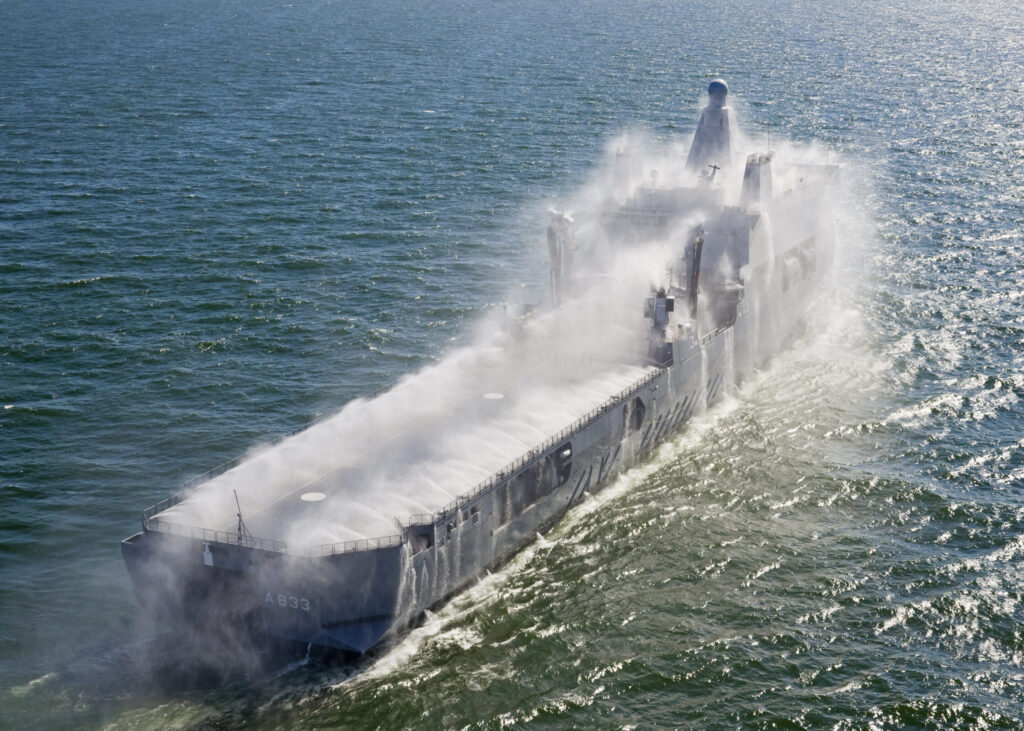 During the sea trials, tests were carried out to the system that can flush the ship clean in the event of a chemical attack.
During the sea trials, tests were carried out to the system that can flush the ship clean in the event of a chemical attack.

